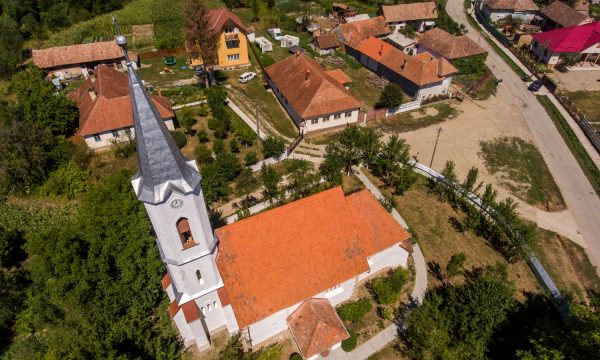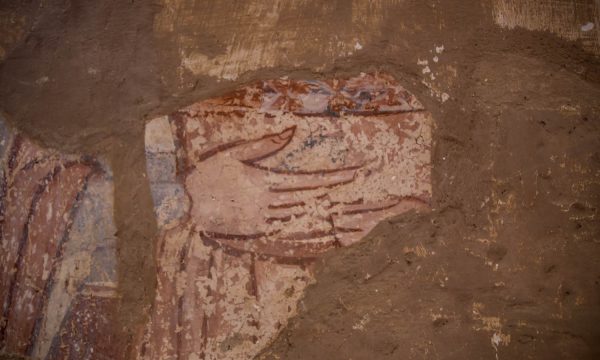Wall painting
One of the most valuable relics of the church are the murals situated on the inner side of the triumphal arch, portraying two figures. The 14th century murals are considered quite early in the context of Transylvanian painting. Although the identification of the figures is challenging, the crown of the southern figure indicates a royal title, as do the clothes of the other figure.

Apart from these clothes, the only indicators of their identities is their position on the arch; we can see some similar Hungarian royal representations on the murals of historic Upper Hungary (Csetnek – Sk: Štítnik, Poprád – Sk: Poprad, Zsegra – Sk: Žehra, in present-day Slovakia). The portrayal of the Hungarian kings is not a frequent theme amongst our murals. In Transylvania there are only a few examples: three from Hațeg (Hu: Hátszeg) region, (surprisingly enough from medieval Romanian orthodox churches!) and two from Bihor. In the light of these information, it seems that the mural from Fizeșu Gherlii might be the first example of this kind of royal portrayal from the central part of Transylvania.

Based on the noted analogies the southern figure’s beard from Fizeșu Gherlii recalls most likely the representation of Saint Ladislaus (according to the common iconography, Saint Stephen is portrayed with long, white beard, while his son, Saint Emeric is shown without beard). It is also interesting that the figures from this often unnoted mural show a strange familiarity with the characters present in the Legend of Margaret of Antioch from the reformed church of Sic (Hu: Szék) and the Last Supper representation from Cricău (Hu: Boroskrakkó). These two both show characteristics of the Italo-Byzantine style. This style – originating from Italy – reached Transylvania in the first decades of the 14th century and had a great influence on the region’s murals. On that score we can say that the murals from Fizeșu Gherlii are one of the first known representations of the Hungarian kings from the whole territory of Medieval Hungary.
Natural Heritage
A village in Câmpia Transilvaniei (Hu: Mezőség) named after its willows and its devilish, dangerous marshland. The landscape is very heterogeneous as more natural habitats include wetlands, pastures and deciduous forests with coppice borders. The Ciucas-lake (Hu: Csukás-tó), a Natura 2000 Nature Conservation Area (ROSCI0099) lies just 9 km southwest, being one of the deepest natural lakes in the country. It is the only lake in Transylvania on which floating reeds grows, like in the Danube Delta, and that has not fallen to harmful human activities. The waters provide rest areas for numerous migratory birds. In the lake, as its name shows [csuka (Hu) means “pike”], a predatory fish species, the northern pike (Esox lucius) can be observed. Among the fish, there are also the crucian carp (Carassius carassius), the doctor fish, (Tinca tinca) and the common bream (Abramis brama). More than a hundred bird species were identified in the special bird conservation area, 30 of them live in wet habitats. Of those, the little bittern (Ixobrychus minutus) and the western marsh harrier (Circus aeruginosus) are rare in Europe. Among the hills around Sic (Hu: Szék), the colchium (Bulbocodium versicolor), the Serratula wolffii and the Iris pontica globally endangered species can be observed. The Plebejus pylaon, a butterfly, and the endemic (meaning that this sub-species lives only here) Astragalus exscapus ssp. Transsilvanicus are also great treasures. There are only two populations of the Centaurea ruthenica in the Transylvanian basin, both in the Mezőség region. We can find them on the edges of forests and in the shrubs. The area can be easily reached from Bonțida (Hu:Bonchida) and Sic villages.
